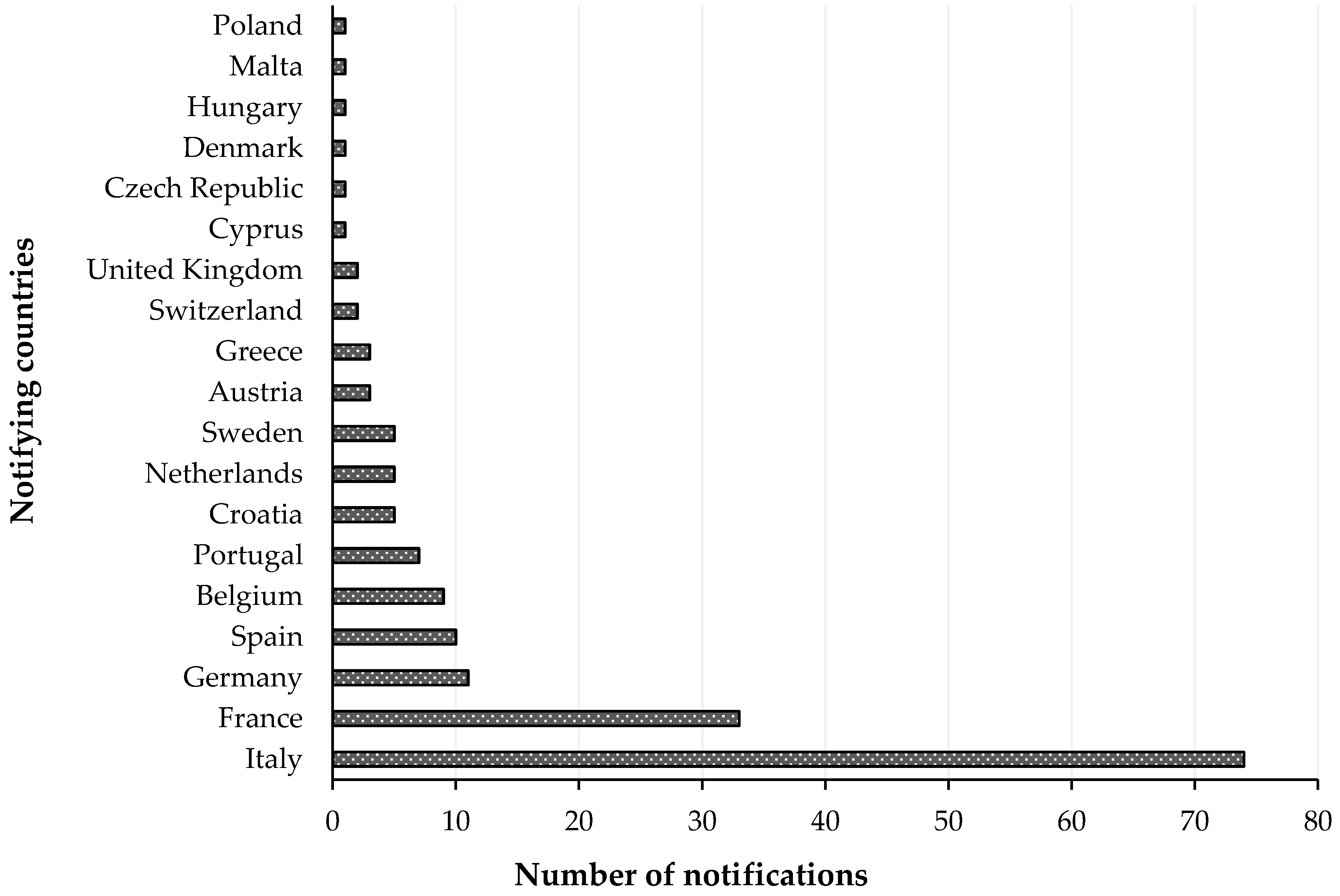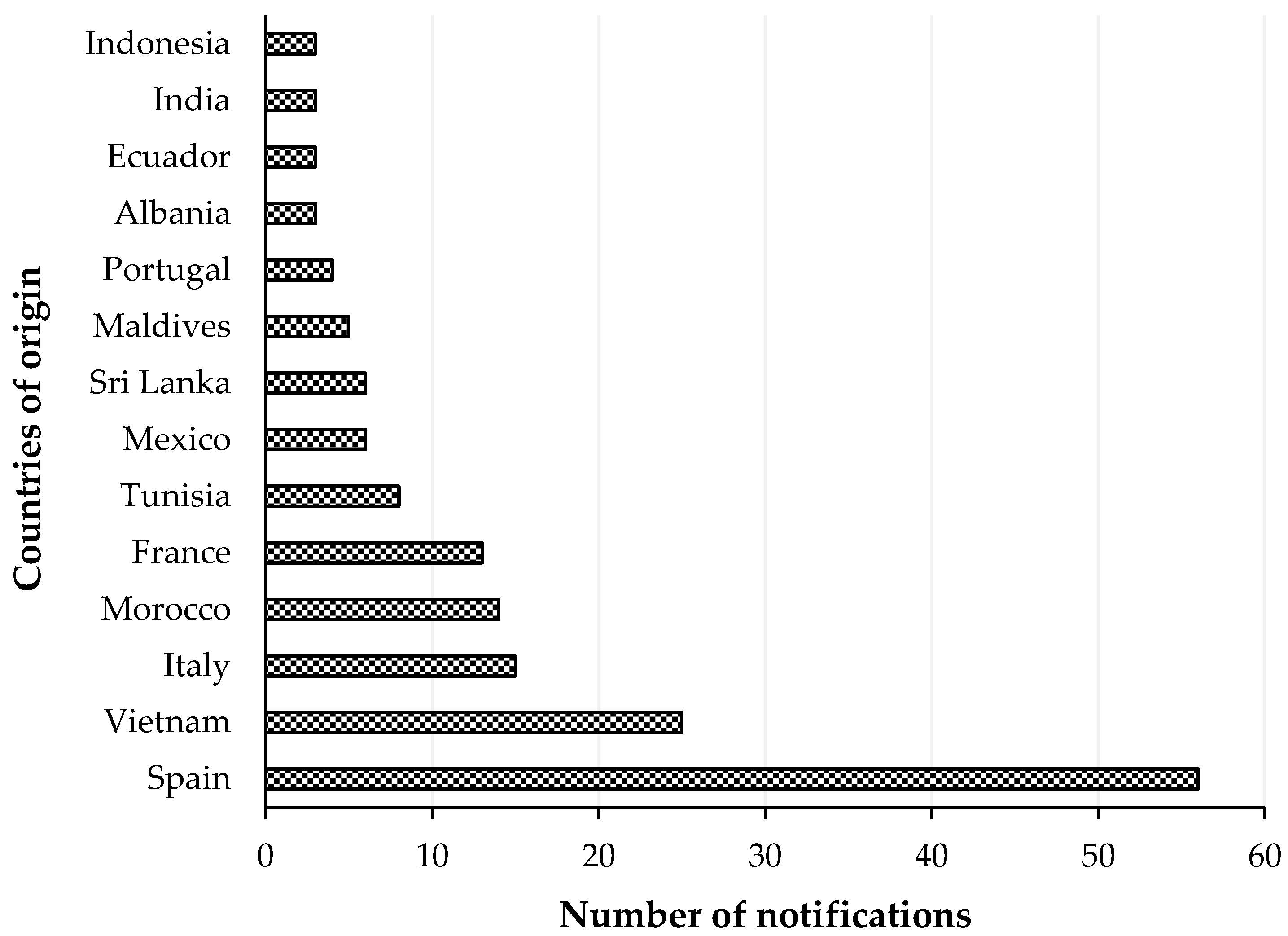An Overview of Histamine and Other Biogenic Amines in Fish and Fish Products
Abstract
:1. Introduction
2. Biogenic Amines in Seafood: Focus on Scombroid Poisoning Outbreaks
3. Factors Affecting Biogenic Amine Formation in Fresh and Processed Seafood
4. Preventive and Control Measures
5. Trend and Challenges of Detection Technologies
6. Conclusions
Author Contributions
Funding
Conflicts of Interest
References
- Zhong, X.; Huo, D.; Fa, H.; Luo, X.; Wang, Y.; Zhao, Y.; Hou, C. Rapid and ultrasensitive detection of biogenic amines with colorimetric sensor array. Sens. Actuators B Chem. 2018, 274, 464–471. [Google Scholar] [CrossRef]
- Biji, K.B.; Ravishankar, C.N.; Venkateswarlu, R.; Mohan, C.O.; Srinivasa Gopal, T.K. Biogenic amines in seafood: A review. J. Food Sci. Technol. 2016, 53, 2210–2218. [Google Scholar] [CrossRef]
- Visciano, P. Chemicals and Safety of Chemical Contaminants in Seafood. In Food Safety Chemistry. Toxicant Occurrence, Analysis and Mitigation; Liangli, L.Y., Shuo, W., Bao-Guo, S., Eds.; CRC Press; Taylor & Francis Group: Boca Raton, FL, USA, 2015; pp. 215–236. [Google Scholar]
- Kuley, E.; Durmus, M.; Balikci, E.; Ucar, Y.; Regenstein, J.M.; Özoğul, F. Fish spoilage bacterial growth and their biogenic amine accumulation: Inhibitory effect of olive by-products. Int. J. Food Prop. 2017, 20, 1029–1043. [Google Scholar] [CrossRef] [Green Version]
- Hungerford, J.M. Scombroid poisoning: A review. Toxicon 2010, 56, 231–243. [Google Scholar] [CrossRef] [PubMed] [Green Version]
- Doeun, D.; Davaatseren, M.; Chung, M.S. Biogenic amines in foods. Food Sci. Biotechnol. 2017, 26, 1463–1474. [Google Scholar] [CrossRef] [PubMed]
- Barbieri, F.; Montanari, C.; Gardini, F.; Tabanelli, G. Biogenic amine production by Lactic Acid Bacteria: A review. Foods 2019, 8, 17. [Google Scholar] [CrossRef] [PubMed] [Green Version]
- Xu, Y.; Zang, J.; Regenstein, J.M.; Xia, W. Technological roles of microorganisms in fish fermentation: A review. Crit. Rev. Food Sci. Nutr. 2020, 1–13. [Google Scholar] [CrossRef]
- Marcobal, A.; De Las Rivas, B.; Landete, J.M.; Tabera, L.; Muñoz, R. Tyramine and phenylethylamine biosynthesis by food bacteria. Crit. Rev. Food Sci. Nutr. 2012, 52, 448–467. [Google Scholar] [CrossRef] [Green Version]
- Wunderlichová, L.; Buňková, L.; Koutný, M.; Jančová, P.; Buňka, F. Formation, degradation, and detoxification of putrescine by foodborne bacteria: A review. Compr. Rev. Food Sci. Food Saf. 2014, 13, 1012–1030. [Google Scholar] [CrossRef]
- Paleologos, E.K.; Savvaidis, I.N.; Kontominas, M.G. Biogenic amines formation and its relation to microbiological and sensory attributes in ice-stored whole, gutted and filleted Mediterranean Sea bass (Dicentrarchus labrax). Food Microbiol. 2004, 21, 549–557. [Google Scholar] [CrossRef]
- FAO/WHO (Food and Agriculture Organization of the United Nations/World Health Organization). Public Health Risks of Histamine and Other Biogenic Amines from Fish and Fishery Products. Meeting Report; FAO Headquarters: Rome, Italy, 2012. [Google Scholar]
- Comas-Basté, O.; Latorre-Moratalla, M.L.; Sánchez-Pérez, S.; Veciana-Nogués, M.T.; Vidal-Carou, M.C. Histamine and other biogenic amines in food. From Scombroid Poisoning to histamine intolerance. In Biogenic Amines; Proestos, C., Ed.; IntechOpen: London, UK, 2019. [Google Scholar]
- Fusek, M.; Michálek, J.; Buñková, L.; Buñka, F. Modelling biogenic amines in fish meat in Central Europe using censored distributions. Chemosphere 2020, 251, 126390. [Google Scholar] [CrossRef] [PubMed]
- Stratta, P.; Badino, G. Scombroid poisoning. CMAJ 2012, 184, 674. [Google Scholar] [CrossRef] [PubMed] [Green Version]
- Palomino-Vasco, M.; Acedo-Valenzuela, M.I.; Rodríguez-Cáceres, M.I.; Mora-Diez, N. Automated chromatographic method with fluorescent detection to determine biogenic amines and amino acids. Application to craft beer brewing process. J. Chromatogr. A 2019, 1601, 155–163. [Google Scholar] [CrossRef] [PubMed]
- Silva, I.P.; Dias, L.G.; da Silva, M.O.; Machado, C.S.; Paula, V.M.B.P.; Evangelista-Barreto, N.S.; de Carvalho, C.A.L.; Estevinho, L.M. Detection of biogenic amines in mead of social bee. LWT Food Sci. Technol. 2020, 121, 108969. [Google Scholar] [CrossRef]
- Prester, L. Biogenic amines in fish, fish products and shellfish: A review. Food Addit. Contam. 2011, 28, 1547–1560. [Google Scholar] [CrossRef] [PubMed]
- Visciano, P.; Schirone, M.; Tofalo, R.; Suzzi, G. Biogenic amines in raw and processed seafood. Front. Microbiol. 2012, 3, 188. [Google Scholar] [CrossRef] [Green Version]
- Mattsson, L.; Xu, J.; Preininger, C.; Bui, B.T.S.; Haupt, K. Competitive fluorescent pseudo-immunoassay exploiting molecularly imprinted polymers for the detection of biogenic amines in fish matrix. Talanta 2018, 181, 190–196. [Google Scholar] [CrossRef]
- Sedaghati, M.; Mooraki, N. Biogenic amines in sea products. J. Surv. Fish. Sci. 2019, 6, 1–8. [Google Scholar] [CrossRef]
- Muscarella, M.; Lo Magro, S.; Campaniello, M.; Armentano, A.; Stacchini, P. Survey of histamine levels in fresh fish and fish products collected in Puglia (Italy) by ELISA and HPLC with fluorometric detection. Food Control 2013, 31, 211–217. [Google Scholar] [CrossRef]
- FDA (Food and Drug Administration). Fish and Fishery Products Hazards and Controls Guidance, 4th ed.; Chapter 7—Scombrotoxin (Histamine) Formation; FDA: Silver Spring, MD, USA, 2020; pp. 113–152.
- Colombo, F.M.; Cattaneo, P.; Confalonieri, E.; Bernardi, C. Histamine food poisonings: A systematic review and meta-analysis. Crit. Rev. Food Sci. 2018, 58, 1131–1151. [Google Scholar] [CrossRef] [Green Version]
- Visciano, P.; Campana, G.; Annunziata, L.; Vergara, A.; Ianieri, A. Effect of storage temperature on histamine formation in Sardina pilchardus and Engraulis encrasicolus after catch. J. Food Biochem. 2007, 31, 577–588. [Google Scholar] [CrossRef]
- Guergué-Díaz de Cerio, O.; Barrutia-Borque, A.; Gardeazabal-García, J. Scombroid poisoning: A practical approach. Actas Dermodifiliogr. 2016, 107, 567–571. [Google Scholar] [CrossRef] [PubMed]
- EFSA and ECDC (European Food Safety Authority and European Centre for Disease Prevention and Control). The European Union One Health 2018 Zoonoses Report. EFSA J. 2019, 17, 5926. [Google Scholar]
- EFSA and ECDC (European Food Safety Authority and European Centre for Disease Prevention and Control). The European Union summary report on trends and sources of zoonoses, zoonotic agents and food-borne outbreaks in 2017. EFSA J. 2018, 16, 5500. [Google Scholar]
- EFSA and ECDC (European Food Safety Authority and European Centre for Disease Prevention and Control). The European Union summary report on trends and sources of zoonoses, zoonotic agents and food-borne outbreaks in 2016. EFSA J. 2017, 15, 55077. [Google Scholar]
- EFSA and ECDC (European Food Safety Authority and European Centre for Disease Prevention and Control). The European Union summary report on trends and sources of zoonoses, zoonotic agents and food-borne outbreaks in 2015. EFSA J. 2016, 14, 4634. [Google Scholar]
- EFSA and ECDC (European Food Safety Authority and European Centre for Disease Prevention and Control). The European Union summary report on trends and sources of zoonoses, zoonotic agents and food-borne outbreaks in 2014. EFSA J. 2015, 13, 4329. [Google Scholar]
- EFSA and ECDC (European Food Safety Authority and European Centre for Disease Prevention and Control). The European Union summary report on trends and sources of zoonoses, zoonotic agents and food-borne outbreaks in 2013. EFSA J. 2015, 13, 3991. [Google Scholar] [CrossRef] [Green Version]
- EFSA and ECDC (European Food Safety Authority and European Centre for Disease Prevention and Control). The European Union summary report on trends and sources of zoonoses, zoonotic agents and food-borne outbreaks in 2012. EFSA J. 2014, 12, 3547. [Google Scholar] [CrossRef]
- EFSA and ECDC (European Food Safety Authority and European Centre for Disease Prevention and Control). The European Union summary report on trends and sources of zoonoses, zoonotic agents and food-borne outbreaks in 2011. EFSA J. 2013, 11, 3129. [Google Scholar] [CrossRef]
- EFSA and ECDC (European Food Safety Authority and European Centre for Disease Prevention and Control). The European Union summary report on trends and sources of zoonoses, zoonotic agents and food-borne outbreaks in 2010. EFSA J. 2012, 10, 2597. [Google Scholar]
- Mercogliano, R.; Santonicola, S. Scombroid fish poisoning: Factors influencing the production of histamine in tuna supply chain. A review. LWT Food Sci. Technol. 2014, 114, 108374. [Google Scholar] [CrossRef]
- Ekici, K.; Omer, A.K. Biogenic amines formation and their importance in fermented foods. In BIO Web of Conferences; EDP Sciences: Ulis, France, 2020; Volume 17, p. 00232. [Google Scholar]
- Gardini, F.; Özogul, Y.; Suzzi, G.; Tabanelli, G.; Özogul, F. Technological factors affecting biogenic amines content in foods: A review. Front. Microbiol. 2016, 7, 1218. [Google Scholar] [CrossRef] [PubMed] [Green Version]
- Tabanelli, G.; Montanari, C.; Gardini, F. Biogenic amines in food: A review of factors affecting their formation. Ref. Modul. Food Sci. Encycl. Food Chem. 2019, 1, 337–343. [Google Scholar]
- Stonehouse, G.G.; Evans, J.A. The use of supercooling for fresh foods: A review. J. Food Eng. 2015, 148, 74–79. [Google Scholar] [CrossRef] [Green Version]
- Sampels, S. The effects of storage and preservation technologies on the quality of fish products: A review. J. Food Process. Preserv. 2015, 39, 1206–1215. [Google Scholar] [CrossRef]
- Karoui, R.; Hassoun, A.; Ethuin, P. Front face fluorescence spectroscopy enables rapid differentiation of fresh and frozen- thawed sea bass (Dicentrarchus labrax) fillets. J. Food Eng. 2017, 202, 89–98. [Google Scholar] [CrossRef]
- Ghanbari, M.; Jami, M.; Domig, K.J.; Kneifel, W. Seafood biopreservation by lactic acid bacteria—A review. LWT Food Sci. Technol. 2013, 54, 315–324. [Google Scholar] [CrossRef]
- Tsironi, T.; Houhoula, D.; Taokis, P. Hurdle technology for fish preservation. Aquac. Fish. 2020, 5, 65–71. [Google Scholar] [CrossRef]
- Lee, Y.C.; Kung, H.F.; Huang, C.Y.; Huang, T.C.; Tsai, Y.H. Reduction of histamine and biogenic amines during salted fish fermentation by Bacillus polymyxa as a starter culture. J. Food Drug Anal. 2016, 24, 157–163. [Google Scholar] [CrossRef] [Green Version]
- Khan, I.; Tango, C.N.; Miskeen, S.; Lee, B.H.; Oh, D.H. Hurdle technology: A novel approach for enhanced food quality and safety-a review. Food Control 2017, 73, 1426–1444. [Google Scholar] [CrossRef]
- Tsironi, T.N.; Taokis, P.S. Modeling microbial spoilage and quality of gilthead seabream fillets: Combined effect of osmotic pre-treatment, modified atmosphere packaging and nisin on shelf life. J. Food Sci. 2010, 75, 243–251. [Google Scholar] [CrossRef] [PubMed]
- Hassoun, A.; Çoban, O.E. Essential oils for antimicrobial and antioxidant applications in fish and other seafood products. Trends Food Sci. Technol. 2017, 68, 26–36. [Google Scholar] [CrossRef]
- Qian, Y.; Yang, S.; Ye, J.X.; Xie, J. Effect of quercetin-containing preservatives and modified atmospheric packaging on the production of biogenic amines in Pacific white shrimp (Litopenaeus vannamei). Aquac. Fish. 2018, 3, 254–259. [Google Scholar] [CrossRef]
- Bono, G.; Badalucco, C. Combining ozone and modified atmosphere packaging (MAP) to maximize shelf-life and quality of striped red mullet (Mullus surmuletus). LWT-Food Sci. Technol. 2012, 47, 500–504. [Google Scholar] [CrossRef]
- Rodrigues, B.L.; Alvares, T.D.S.; Sampaio, G.S.L.; Cabral, C.C.; Araujo, J.V.A.; Franco, R.M.; Mano, S.B.; Conte-Junior, C.A. Influence of vacuum and modified atmosphere packaging in combination with UV-C radiation on the shelf life of rainbow trout (Oncorhynchus mykiss) fillets. Food Control 2016, 60, 596–605. [Google Scholar] [CrossRef] [Green Version]
- Yew, C.C.; Bakar, F.A.; Rahman, R.A.; Bakar, J.; Zaman, M.Z.; Velu, S.; Shariat, M. Effects of modified atmosphere packaging with various carbon dioxide composition on biogenic amines formation in Indian mackerel (Rastrelliger kanagurta) stored at 5 ± 1 °C. Packag. Technol. Sci. 2014, 27, 249–254. [Google Scholar] [CrossRef]
- Bottino, F.D.O.; Rodrigues, B.L.; De Nunes Ribeiro, J.D.; Lázaro, C.A.; Conte-Junior, C.A. Influence of UV-C radiation on shelf life of vacuum package tambacu (Colossoma macropomum × Piaractus mesopotamicus) fillets. J. Food Process. Preserv. 2016, 41, e13003. [Google Scholar] [CrossRef]
- Özogul, F.; Özden, Ö. The effects of gamma irradiation on the biogenic amine formation in sea bream (Sparus aurata) stored in ice. Food Bioprocess. Technol. 2013, 6, 1343–1349. [Google Scholar] [CrossRef]
- Truong, B.Q.; Buckow, R.; Stathopoulos, C.E.; Nguyen, M.H. Advances in high-pressure processing of fish muscles. Food Eng. Rev. 2014, 7, 109–129. [Google Scholar] [CrossRef]
- Doeun, D.; Shin, H.-S.; Chung, M.-S. Effects of storage temperatures, vacuum packaging, and high hydrostatic pressure treatment on the formation of biogenic amines in Gwamegi. Appl. Biol. Chem. 2016, 59, 51–58. [Google Scholar] [CrossRef]
- Baptista, R.C.; Horita, C.N.; Sant’Ana, A.S. Natural products with preservative properties for enhancing the microbiological safety and extending the shelf-life of seafood: A review. Food Res. Int. 2020, 127, 108762. [Google Scholar] [CrossRef] [PubMed]
- Calo, J.R.; Crandall, P.G.; O’Bryan, C.A.; Ricke, S.C. Essential oils as antimicrobials in food systems—A review. Food Control 2015, 54, 111–119. [Google Scholar] [CrossRef]
- Bakkali, F.; Averbeck, S.; Averbeck, D.; Idaomar, M. Biological effects of essential oils—A review. Food Chem. Toxicol. 2008, 46, 446–475. [Google Scholar] [CrossRef]
- Hyldgaard, M.; Mygind, T.; Meyer, R.L. Essential oils in food preservation: Mode of action, synergies, and interactions with food matrix components. Front. Microbiol. 2012, 3, 12. [Google Scholar] [CrossRef] [PubMed] [Green Version]
- Swamy, M.K.; Akhtar, M.S.; Sinniah, U.R. Antimicrobial properties of plant essential oils against human pathogens and their mode of actions: An updated review. Evid. Based Complement. Altern. Med. 2016, 21, 3012462. [Google Scholar] [CrossRef]
- Özogul, F.; Kuley, E.; Kenar, M. Effects of rosemary and sage tea extract on biogenic amines formation of sardine (Sardina pilchardus) fillets. Int. J. Food Sci. Technol. 2011, 46, 761–766. [Google Scholar] [CrossRef]
- Cai, L.; Cao, A.; Li, Y.; Song, Z.; Leng, L.; Li, Y. The effects of essential oil treatment on the biogenic amines inhibition and quality preservation of red drum (Sciaenops ocellatus) fillets. Food Control 2015, 56, 1–8. [Google Scholar] [CrossRef]
- Houicher, A.; Kuley, E.; Özogul, F.; Bendeddouche, B. Effect of natural extracts (Mentha spicata L. and Artemisia campestris) on biogenic amine formation of sardine vacuum-packed and refrigerated (Sardina pilchardus) fillets. J. Food Process. Pres. 2015, 39, 2393–2403. [Google Scholar] [CrossRef]
- Kuley, E.; Yavuzer, M.N.; Yavuzer, E.; Durmuş, M.; Yazgan, H.; Gezginç, Y.; Özogul, F. Inhibitory effects of safflower and bitter melon extracts on biogenic amine formation by fish spoilage bacteria and food borne pathogens. Food Biosci. 2019, 32, 100478. [Google Scholar] [CrossRef]
- Alfonzo, A.; Martorana, A.; Guarrasi, V.; Barbera, M.; Gaglio, R.; Santulli, A.; Settanni, L.; Galati, A.; Moschetti, G.; Francesca, N. Effect of the lemon essential oils on the safety and sensory quality of salted sardines (Sardina pilchardus Walbaum 1972). Food Control 2017, 73, 1265–1274. [Google Scholar] [CrossRef] [Green Version]
- Doğan, G.; İzci, L. Effects on quality properties of smoked rainbow trout (Oncorhynchus mykiss) fillets of chitosan films enriched with essential oils. J. Food Process. Preserv. 2017, 41, e12757. [Google Scholar] [CrossRef] [Green Version]
- Yuan, G.; Lv, H.; Tang, W.; Zhang, X.; Sun, H. Effect of chitosan coating combined with pomegranate peel extract on the quality of Pacific white shrimp during iced storage. Food Control 2016, 59, 818–823. [Google Scholar] [CrossRef]
- Atarés, L.; Chiralt, A. Essential oils as additives in biodegradable films and coatings for active food packaging. Trends Food Sci. Technol. 2016, 48, 51–62. [Google Scholar] [CrossRef]
- Ribeiro-Santos, R.; Andrade, M.; Ramos de Melo, N.; Sanches-Silva, A. Use of essential oils in active food packaging: Recent advances and future trends. Trends Food Sci. Technol. 2017, 61, 132–140. [Google Scholar] [CrossRef]
- Emir Çoban, O.; Özpolat, E. The effects of different concentrations of rosemary (rosmarinus officinalis) extract on the shelf life of hot-smoked and vacuum-packed luciobarbus esocinus fillets. J. Food Process. Preserv. 2013, 37, 269–274. [Google Scholar] [CrossRef]
- Li, T.; Li, J.; Hu, W.; Zhang, X.; Li, X.; Zhao, J. Shelf-life extension of crucian carp (Carassius auratus) using natural preservatives during chilled storage. Food Chem. 2012, 135, 140–145. [Google Scholar] [CrossRef]
- Pezeshk, S.; Ojagh, S.M.; Alishahi, A. Effect of plant antioxidant and antimicrobial compounds on the shelf-life of seafood—A review. Czech J. Food Sci. 2015, 33, 195–203. [Google Scholar] [CrossRef] [Green Version]
- Alishahi, A.; Äider, M. Applications of chitosan in the seafood industry and aquaculture: A review. Food Bioproc. Technol. 2012, 5, 817–830. [Google Scholar] [CrossRef]
- Yuan, G.; Chen, X.; Li, D. Chitosan films and coatings containing essential oils: The antioxidant and antimicrobial activity, and application in food systems. Food Res. Int. 2016, 89, 117–128. [Google Scholar] [CrossRef]
- Naila, A.; Flint, S.; Fletcher, G.; Bremer, P.; Meerdink, G. Control of biogenic amines in food—Existing and emerging approaches. J. Food Sci. 2010, 75, R139–R150. [Google Scholar] [CrossRef] [PubMed] [Green Version]
- EFSA Panel on Biological Hazards (BIOHAZ). Scientific Opinion on Scientific Opinion on risk based control of biogenic amine formation in fermented foods. EFSA J. 2011, 9, 2393. [Google Scholar] [CrossRef] [Green Version]
- Lázaro, C.A.; Conte-Junior, C.A. Detection of biogenic amines: Quality and toxicity indicators in food of animal origin. In Food Control and Biosecurity; Holban, A.M., Grumezescu, A.M., Eds.; Elsevier: Amsterdam, The Netherlands, 2018; Volume 16, pp. 225–257. [Google Scholar]
- Verkhivker, Y.; Altman, E. Influence parameters of storage on process of formation the histamine in fish and fish products. J. Water Res. Ocean. Sci. 2018, 7, 10–14. [Google Scholar] [CrossRef]
- Visciano, P.; Schirone, M.; Tofalo, R.; Suzzi, G. Histamine poisoning and control measures in fish and fishery products. Front. Microbiol. 2014, 5, 500. [Google Scholar] [CrossRef] [PubMed] [Green Version]
- Surya, T.; Sivaraman, B.; Alamelu, V.; Priyatharshini, A.; Arisekar, U.; Sundhar, S. Rapid methods for histamine detection in fishery products. Int. J. Curr. Microbiol. Appl. Sci. 2019, 8, 2035–2046. [Google Scholar] [CrossRef]
- Papageorgiou, M.; Lambropoulou, D.; Morrison, C.; Kłodzińska, E.; Namieśnik, J.; Płotka-Wasylka, J. Literature update of analytical methods for biogenic amines determination in food and beverages. Trends Analyt. Chem. 2018, 98, 128–142. [Google Scholar] [CrossRef] [Green Version]
- Alonso-Lomillo, M.A.; Domínguez-Renedo, O.; Matos, P.; Arcos-Martínez, M.J. Disposable biosensors for determination of biogenic amines. Anal. Chim. Acta 2010, 665, 26–31. [Google Scholar] [CrossRef]
- Önal, A. A Review: Current analytical methods for the determination of biogenic amines in foods. Food Chem 2007, 103, 1475–1486. [Google Scholar] [CrossRef]
- Patange, S.B.; Mukundan, M.K.; Ashok Kumar, K. A simple and rapid method for colorimetric determination of histamine in fish flesh. Food Control 2005, 16, 465–472. [Google Scholar] [CrossRef]
- Tao, Z.; Sato, M.; Han, Y.; Tan, Z.; Yamaguchi, T.; Nakano, T. A simple and rapid method for histamine analysis in fish and fishery products by TLC determination. Food Control 2011, 22, 1154–1157. [Google Scholar] [CrossRef]
- Machiels, D.; Van Ruth, S.M.; Posthumus, M.A.; Istasse, L. Gas chromatography-olfactometry analysis of the volatile compounds of two commercial Irish beef meat. Talanta 2003, 60, 755–764. [Google Scholar] [CrossRef]
- Young, J.A.; Jiang, X.; Kirchhoff, J.R. Amperometric detection of histamine with a pyrroloquinoline-quinone modified electrode. Electroanalysis 2013, 25, 1589–1593. [Google Scholar] [CrossRef]
- Yadav, S.; Nair, S.S.; Sai, V.V.R.; Satija, J. Nanomaterials based optical and electrochemical sensing of histamine: Progress and perspectives. Food Res. Int. 2019, 119, 99–109. [Google Scholar] [CrossRef] [PubMed]
- Zhang, Y.-J.; Zhang, Y.; Zhou, Y.; Li, G.-H.; Yang, W.-Z.; Feng, X.-S. A review of pretreatment and analytical methods of biogenic amines in food and biological samples since 2010. J. Chromatogr. A 2019, 1605, 360361. [Google Scholar] [CrossRef]
- Zang, X.; Zhou, Q.; Chang, J.; Liu, Y.; Lin, L. Graphene and carbon nanotube (CNT) in MEMS/NEMS applications. Microelectron. Eng. 2015, 132, 192–206. [Google Scholar] [CrossRef]
- Liao, M.; Koide, Y. Carbon-based materials: Growth, properties, MEMS/NEMS technologies, and MEM/NEM switches. Crit. Rev. Solid State 2011, 36, 66–101. [Google Scholar] [CrossRef]
- Jian, R.S.; Huang, R.X.; Lu, C.J. A micro GC detector array based on chemiresistors employing various surface functionalized monolayer-protected gold nanoparticles. Talanta 2012, 88, 160–167. [Google Scholar] [CrossRef]
- Rajdi, N.N.Z.M.; Salleh, S.M.; Bakir, A.A.; Yuen, A.; Wicaksono, D.H.B.; Harun, F.K.C. Silver nanoparticles stamping for the production of fabrics-based bio-MEMS. In Proceedings of the International Conference on Robotics, Biomimetics, Intelligent Computational Systems, Jogjakarta, Indonesia, 25–27 November 2013; pp. 10–14. [Google Scholar]
- Chow, C.F. Biogenic amines- and sulfides-responsive gold nanoparticles for real-time visual detection of raw meat, fish, crustaceans, and preserved meat. Food Chem. 2020, 311, 125908. [Google Scholar] [CrossRef]
- Siripongpreda, T.; Siralertmukul, K.; Rodthongkum, N. Colorimetric sensor and LDI-MS detection of biogenic amines in food spoilage based on porous PLA and graphene oxide. Food Chem. 2020, 329, 127165. [Google Scholar] [CrossRef]




| Precursors | Biogenic Amines | ||
|---|---|---|---|
| Aliphatic | Aromatic | Heterocyclic | |
| Arginine | Agmatine | ||
| Lysine | Cadaverine | ||
| Ornithine | Putrescine | ||
| Phenylalanine | Phenylethylamine | ||
| Tyrosine | Tyramine | ||
| Histidine | Histamine | ||
| Tryptophan | Tryptamine | ||
| Biogenic Amine | Microorganisms | References |
|---|---|---|
| Histamine | Morganella morganii, Morganella psychrotolerans, Hafnia alvei, Photobacterium phosphoreum, Photobacterium psychrotolerans, Klebsiella pneumoniae, Clostridium spp., Pseudomonas fluorescens, Pseudomonas putida, Pseudomonas cepaciae, Aeromonas spp., Aeromonas hydrophila, Acinetobacter lowffi, Plesiomonas shigelloides, Proteus vulgaris, Proteus mirabilis, Serratia fonticola, Serratia liquefaciens, Enterobacter cloacae, Enterobacter aerogenes, Klebsiella oxytoca, Citrobacter freundii, Raoultella planticola, Staphylococcus xylosus, Staphylococcus epidermidis, Bacillus spp., Vibrio alginolyticus, Vibrio spp., Escherichia spp. | Hungerforf, 2010 [5] Biji et al., 2016 [2] Doeun et al., 2017 [6] Barbieri et al., 2019 [7] Xu et al., 2020 [8] |
| Tiramine | Lactic acid bacteria (including lactobacilli, lactococci, enterococci and carnobacteria) | Marcobal et al., 2012 [9] |
| Putrescine | Enterobacter spp., Hafnia alvei, Pantoea agglomerans, Serratia liquefaciens, Photobacterium phosphoreum, Aeromonas spp., Lactobacillus curvatus, Lactobacillus sakei, Carnobacterium divergens | Wunderlichová et al., 2014 [10] |
| Cadaverine | Pseudomonads, Enterobacteriaceae | Paleologos et al., 2004 [11] Kuley et al., 2017 [4] |
| Apparatus | Symptoms |
|---|---|
| Integumentary | Face, neck, and upper arm flushing, itchy rash, hives, localized swelling, redness, urticaria, pruritus |
| Cardiovascular | Hypotension with distributive shock, cardiac arrhythmias, myocardial disfunction, acute pulmonary edema, oral numbness, tingling |
| Gastrointestinal | Abdominal pain, stomach cramps, nausea, vomiting, diarrhea |
| Neurological | Throbbing headache, migraines, loss of sight, dizziness, faintness, anxiety, tremor |
| Respiratory | Asthma attacks, respiratory distress, rhinitis, bronchoconstriction, dyspnea |
| Other | Metallic or peppery taste, oral numbness, difficulties in swallowing and thirst, feeling of warmth around the mouth |
| Year | Outbreaks (N) | Cases (N) | |||
|---|---|---|---|---|---|
| Strong-Evidence | Weak-Evidence | Total | Human Cases | Hospitalized | |
| 2018 | 24 | 56 | 80 | 488 | 115 |
| 2017 | 56 | 61 | 117 | 572 | 51 |
| 2016 * | 28 | 78 | 106 | 489 | 74 |
| 2015 | 23 | 57 | 80 | 437 | 43 |
| 2014 | 35 | - ** | 35 | 164 | 15 |
| 2013 | 42 | - | 42 | 231 | 30 |
| 2012 | 34 | - | 34 | 241 | 14 |
| 2011 | 58 | - | 58 | 259 | 31 |
| 2010 | 33 | - | 33 | 185 | 12 |
| Notification | Histamine Concentrations (mg/kg) | |||||
|---|---|---|---|---|---|---|
| ≤200 | >200 and ≤500 | >500 and ≤1000 | >1000 and ≤2000 | >2000 | Total | |
| IA * | 31 (20.6%) | 52 (34.4%) | 23 (15.2%) | 29 (19.2%) | 16 (10.6%) | 151 (100%) |
| Alert | 15 (12.9%) | 35 (30.2%) | 17 (14.7%) | 26 (22.4%) | 23 (19.8%) | 116 (100%) |
| BR ** | 8 (22.2%) | 18 (50%) | 9 (25%) | - | 1 (2.8%) | 36 (100%) |
| Country | Limit | Reference |
|---|---|---|
| EU |
| Commission Regulation (EC) No 2073/2005 and further amendments |
| ||
| Fish sauce produced by fermentation of fishery products n = 1, m = 400 mg/kg | Commission Regulation (EU) No 1019/2013 | |
| US FDA | n = 18, c = 1, m = 50 mg/kg, M = 500 mg/kg n = 18; c = 0, m = 500 mg/kg | FAO/WHO, 2012 |
Publisher’s Note: MDPI stays neutral with regard to jurisdictional claims in published maps and institutional affiliations. |
© 2020 by the authors. Licensee MDPI, Basel, Switzerland. This article is an open access article distributed under the terms and conditions of the Creative Commons Attribution (CC BY) license (http://creativecommons.org/licenses/by/4.0/).
Share and Cite
Visciano, P.; Schirone, M.; Paparella, A. An Overview of Histamine and Other Biogenic Amines in Fish and Fish Products. Foods 2020, 9, 1795. https://doi.org/10.3390/foods9121795
Visciano P, Schirone M, Paparella A. An Overview of Histamine and Other Biogenic Amines in Fish and Fish Products. Foods. 2020; 9(12):1795. https://doi.org/10.3390/foods9121795
Chicago/Turabian StyleVisciano, Pierina, Maria Schirone, and Antonello Paparella. 2020. "An Overview of Histamine and Other Biogenic Amines in Fish and Fish Products" Foods 9, no. 12: 1795. https://doi.org/10.3390/foods9121795





